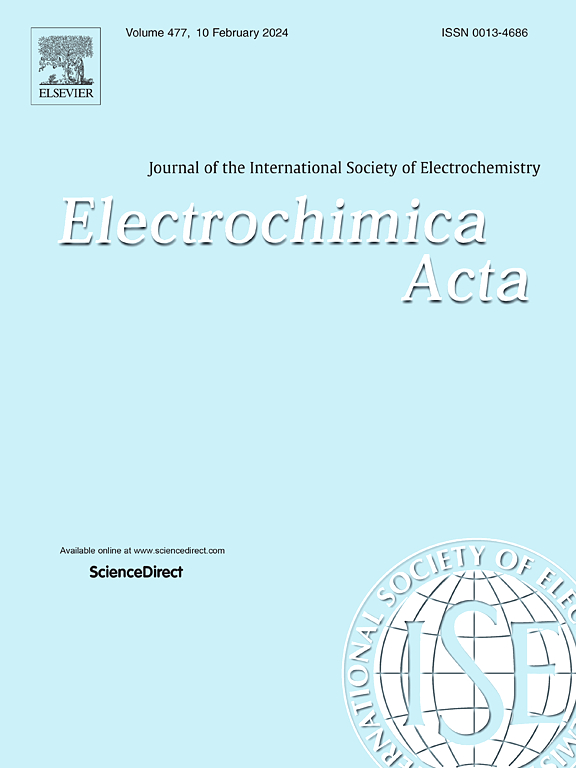使用二元氧化石墨烯/电氧化系统协同消毒多重耐药细菌:对细胞活性和多形性的影响
IF 5.6
3区 材料科学
Q1 ELECTROCHEMISTRY
引用次数: 0
摘要
本研究评估了二元系统的有效性,该系统结合了使用不同钌/铱比例的混合金属氧化物(MMO)电极的电氧化(EO)和游离氯系统中还原氧化石墨烯(rGO)的悬浮液,以灭活金黄色葡萄球菌(对甲氧西林和氧苄西林耐药)和大肠杆菌(对粘菌素耐药)。电化学表征表明,不同Ru/Ir组成的MMO电极表现出不同的析氧反应电位(OER),直接影响细菌灭活效率。在NaCl中,EO可以完全失活,而在13.6 mA/cm²的Na₂SO₄中,只有40%的失活。添加0.05 mg/mL还原氧化石墨烯可将细菌灭活率恢复到100%,但在连续重复使用后其效果有所下降。EDS, XRD和Raman表征证实了还原氧化石墨烯的化学稳定性,而SEM显示颗粒团聚增加,这对其性能产生了负面影响。在Na₂SO₄中协同使用还原氧化石墨烯和EO代表了一种有前途的水消毒替代方案,最大限度地减少了有毒氯化副产物的形成。抗菌机制的证据是在细胞水平上观察到的结构损伤,包括膜破裂、通透性增加和明显的形态变形(多形性),这反映了由于氧化和机械应力导致的细胞完整性丧失。这些发现证明了EO/rGO系统作为一种广谱和可持续的灭活水中多重耐药细菌的消毒策略的潜力。进一步优化操作参数和纳米材料的稳定性对于实现大规模应用至关重要。本文章由计算机程序翻译,如有差异,请以英文原文为准。
Synergistic disinfection of multidrug-resistant bacteria using a binary rGO/electro-oxidation system: Effects on cellular activity and pleomorphism
This study evaluates the effectiveness of a binary system that combines electro-oxidation (EO) using mixed metal oxide (MMO) electrodes with different Ruthenium/Iridium ratios and a suspension of reduced graphene oxide (rGO) in a free chlorine system to inactivate S. aureus (resistant to methicillin and oxacillin) and Escherichia coli (resistant to colistin).
Electrochemical characterization by DEMS and voltammetry showed that MMO electrodes exhibit different oxygen evolution reaction (OER) potentials depending on their Ru/Ir composition, directly influencing bacterial inactivation efficiency. In NaCl, EO alone achieved complete inactivation, while in Na₂SO₄ only 40 % was achieved at 13.6 mA/cm². The addition of 0.05 mg ml−1 of rGO restored bacterial inactivation to 100 %, although its efficacy declined after successive reuse cycles. Characterization by EDS, XRD, and Raman confirmed the chemical stability of rGO, whereas SEM revealed increasing particle agglomeration, which negatively impacted its performance.
The synergistic use of rGO with EO in Na₂SO₄ represents a promising alternative for water disinfection, minimizing the formation of toxic chlorinated byproducts. Evidence of the antibacterial mechanism was supported by observations of structural damage at the cellular level, including membrane rupture, increased permeability, and notable morphological deformations (pleomorphism), which reflect the loss of cell integrity due to oxidative and mechanical stress.
These findings demonstrate the potential of the EO/rGO system as a broad-spectrum and sustainable disinfection strategy for inactivating multidrug-resistant bacteria in water. Further optimization of operational parameters and nanomaterial stability is essential to enable large-scale application.
求助全文
通过发布文献求助,成功后即可免费获取论文全文。
去求助
来源期刊

Electrochimica Acta
工程技术-电化学
CiteScore
11.30
自引率
6.10%
发文量
1634
审稿时长
41 days
期刊介绍:
Electrochimica Acta is an international journal. It is intended for the publication of both original work and reviews in the field of electrochemistry. Electrochemistry should be interpreted to mean any of the research fields covered by the Divisions of the International Society of Electrochemistry listed below, as well as emerging scientific domains covered by ISE New Topics Committee.
 求助内容:
求助内容: 应助结果提醒方式:
应助结果提醒方式:


